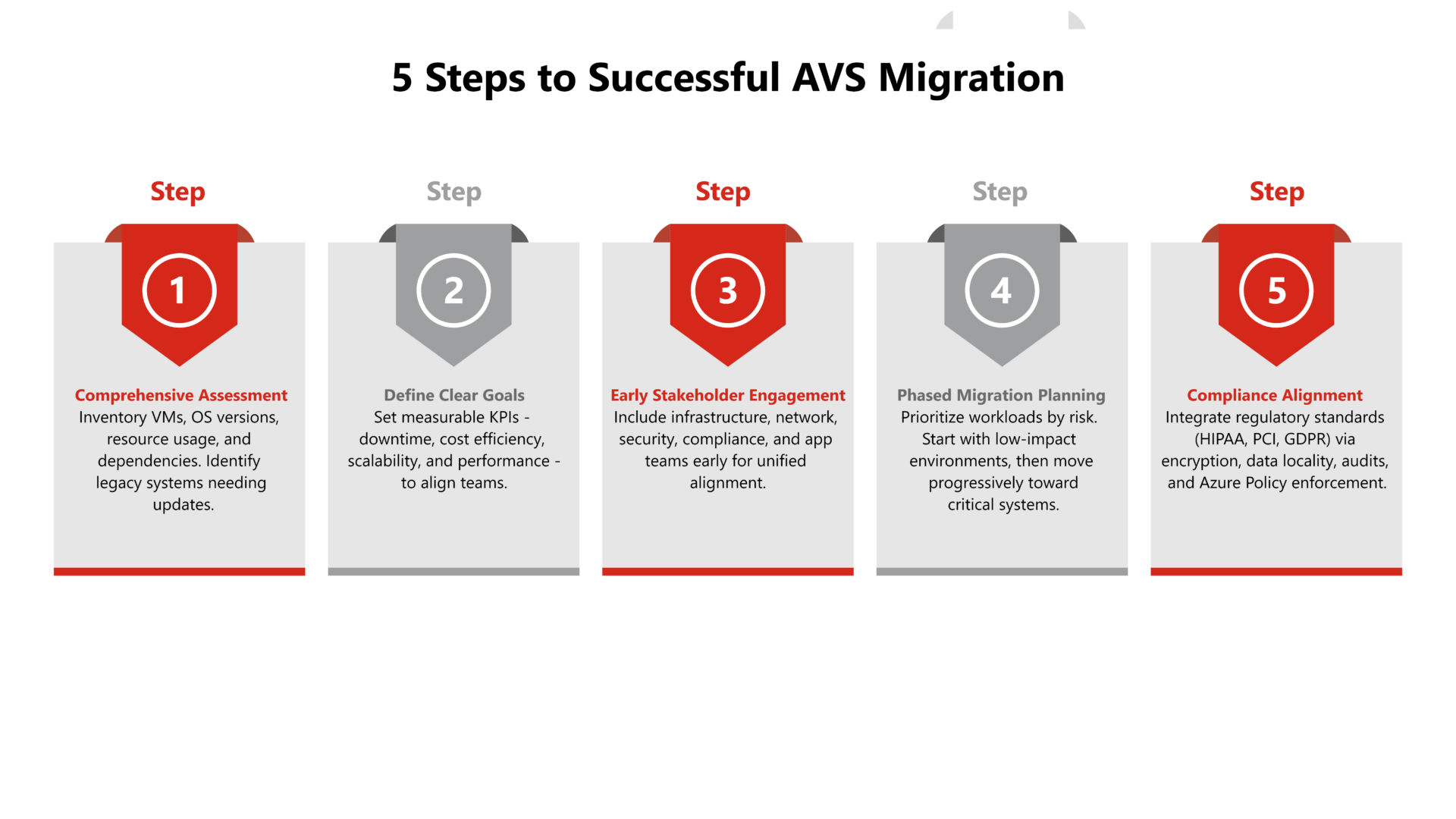Best Practices for Migrating VMware Workloads to Azure VMware Solution (AVS)
Introduction
As enterprises reevaluate their VMware strategy in the wake of escalating licensing costs and Broadcom’s acquisition changes, Azure VMware Solution (AVS) has emerged as a compelling alternative. It enables organizations to migrate existing VMware workloads to Azure with minimal disruption, leveraging familiar tools like vSphere, NSX, and vSAN. But achieving a seamless migration demands more than just technical lift-and-shift—it requires strategic execution. Here’s how to do it right.
This blog distills the essential best practices for migrating VMware workloads to Azure VMware Solution (AVS). Learn how to plan strategically, architect resiliently, and optimize post-migration to ensure a smooth, secure, and cost-effective transition, modernizing your IT infrastructure without rearchitecting core applications.
Pre-Migration Planning: Setting the Foundation for Success
Step 1: Perform a Comprehensive Assessment
Start with a detailed workload inventory using Azure Migrate or similar tools. Capture VM specs, OS versions, application dependencies, and resource consumption trends. Identify any unsupported or legacy systems that require remediation before migration.
Step 2: Define Clear Goals and Success Metrics
Establish migration KPIs—these may include reduced downtime, cost savings, improved scalability, or performance benchmarks. Defining these targets upfront helps align efforts across IT and business teams.
Step 3: Engage Cross-Functional Stakeholders Early
Involve infrastructure, networking, application owners, compliance, and security teams from day one. This collaborative planning prevents misaligned priorities and ensures readiness across all domains.
Step 4: Develop a Phased Migration Plan
Classify workloads based on criticality and create logical waves of migration. Start with low-risk environments to test your process. Gradually progress to core business applications, ensuring stability at each step.
Step 5: Align with Compliance Requirements
If your workloads are subject to regulations like HIPAA, PCI DSS, or GDPR, ensure that encryption, data locality, and audit controls are built into your AVS design. Use Azure Policy and blueprints to enforce these post-migration.
By investing time in meticulous pre-migration planning, you set a solid foundation. The goal is to uncover potential roadblocks on paper (or in a test migration) – not when your production systems are already mid-move. As the saying goes, “measure twice, cut once.” In cloud terms: assess twice, migrate once (with confidence).

Network and Identity Architecture: Building a Resilient Framework
- Adopt a Hub-and-Spoke Model: Deploy AVS in a spoke virtual network and connect to a centralized hub for shared services like DNS and Active Directory. This ensures reliable hybrid connectivity and centralized governance.
- IP Planning: Avoid overlapping subnets between on-prem and AVS to prevent routing conflicts. Use NSX-T to segment networks by workload and security zone, and apply micro-segmentation to limit lateral movement.
- Hybrid Identity Integration: Extend Active Directory into Azure or use Azure AD Domain Services. Enable Multi-Factor Authentication (MFA) and Conditional Access to support a Zero Trust security posture.
Migration Execution: Tools and Techniques
- Leverage VMware HCX: Use HCX for orchestrating migrations—vMotion for live migrations, bulk for large-scale moves, and cold migration for offline workloads.
- Phased Approach: Migrate dependent applications together to maintain integrations. Validate each wave with testing, monitoring, and rollback procedures.
- Resource Allocation: Provision HCX appliances and test bandwidth to avoid throttling. Ensure time synchronization and DNS resolution post-migration to prevent authentication or application issues.
How AI and Automation Accelerate AVS Migration?
Modern AVS migrations increasingly leverage AI and automation to streamline processes and reduce manual effort. AI-driven tools can enhance workload discovery, optimize migration wave planning, and predict resource needs more accurately. For instance, Azure Migrate uses machine learning models to assess VM readiness and suggest ideal target configurations, reducing guesswork.
- Smarter Planning: AI-driven workload assessments through Azure Migrate identify optimal VM configurations, uncover hidden dependencies, and flag unsupported OS versions—cutting down planning cycles.
- Predictive Optimization: Machine learning models forecast compute and storage needs in Azure, helping avoid over-provisioning and resource bottlenecks.
- Proactive Monitoring: Tools like Azure Network Watcher, NSX Intelligence, and Microsoft Defender for Cloud use AI to detect anomalies, monitor traffic patterns, and automate responses to issues.
- Runbook Automation: Orchestrate repeatable tasks (e.g., provisioning HCX, executing VM cutovers, validating apps post-move) using prebuilt automation scripts, reducing human error and accelerating timelines.
- Post-Migration Tuning: AI-driven analytics in Azure Monitor highlight underperforming workloads, identify cost inefficiencies, and recommend tuning actions for long-term performance and cost optimization.
Post-Migration Optimization: Governance, Security, and Cost Control
- Enforce Governance: Apply Azure Policy and tagging to manage AVS workloads as native cloud assets. Integrate with Azure Monitor, Azure Arc, and cost management tools for visibility and control.
- Optimize Resources: Regularly review and right-size VMs to avoid over-provisioning. Utilize reserved instances and Azure Hybrid Benefit for cost savings.
- Strengthen Security: Enable vSAN encryption, configure NSX-T firewalls, and onboard workloads into Microsoft Defender for Cloud. Implement Azure Backup or third-party solutions, as AVS does not provide backups by default.
The post-migration phase is where true cloud value is realized. At this stage, it’s essential to move beyond migration and focus on operational excellence. By prioritizing governance, cost optimization, and security hardening, organizations position themselves to fully leverage the agility of the cloud—while avoiding the common pitfall of a “lift-and-shift and forget” approach. The result is an AVS environment that’s not just operational, but truly optimized: cost-effective, secure, compliant, and ready to drive ongoing innovation.
Pitfalls to Avoid in AVS Migrations
- Incomplete Discovery: Missing app dependencies or unsupported VMs can disrupt production if overlooked. Thorough discovery is non-negotiable.
- Overlapping IP Addresses: Reusing on-prem IP ranges in AVS without proper planning causes routing conflicts and broken connections.
- Siloed Planning: Excluding security, compliance, or app owners from early planning leads to misaligned priorities and post-migration fixes.
- Big Bang Migrations: Moving all workloads at once often results in downtime and rollback challenges. A phased approach offers better control.
- Lack of Governance Post-Move: Treating AVS like on-prem leads to sprawl and security drift. AVS requires cloud governance practices.
- No Rollback Plan: If a cutover fails and on-prem VMs are deleted too early, recovery becomes difficult. Always retain rollback options.
- Skipping Backup Setup: AVS doesn’t include backups by default. Implement a backup strategy before declaring success.
Conclusion: Strategic Migration Yields Long-Term Rewards
Azure VMware Solution provides a streamlined, scalable path to the cloud for organizations with significant VMware investments. However, success hinges on holistic planning, resilient architecture, informed execution, and continuous optimization. By adhering to these best practices and avoiding common pitfalls, enterprises can reduce costs, enhance agility, and modernize their infrastructure without the need to rearchitect core applications.
Being a trusted Microsoft Gold Partner and Azure Managed Services Provider, iLink provides end-to-end AVS migration services, from readiness assessments to post-migration optimization. Let us help you turn your VMware strategy into a cloud-powered success story.
Contact us today for a free AVS readiness assessment!



